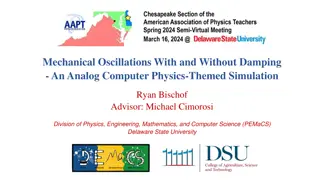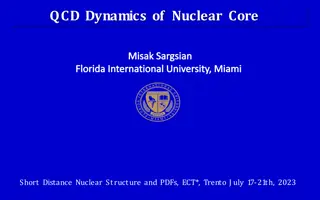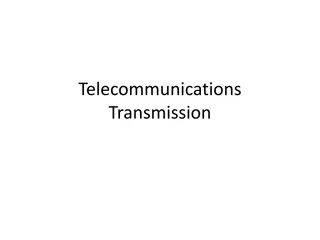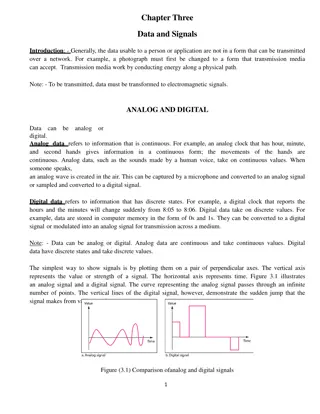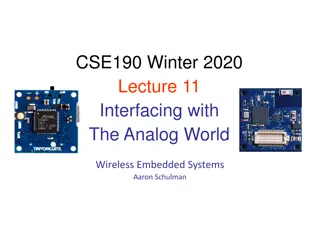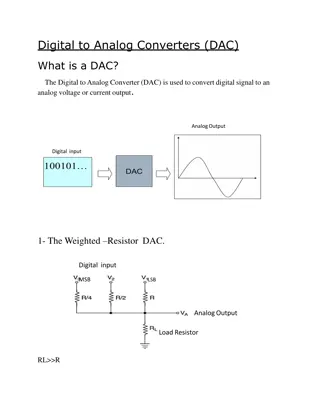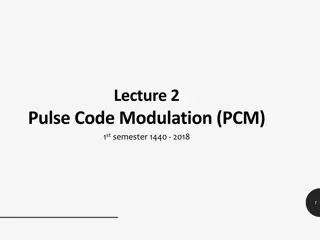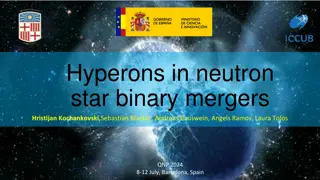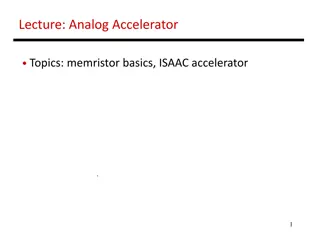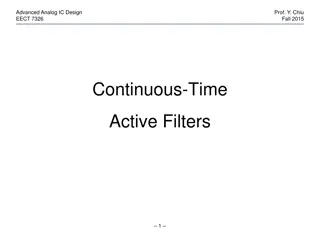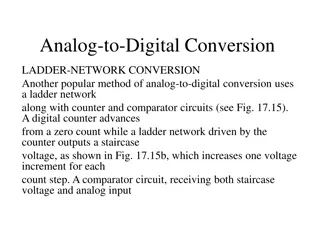Exploring Nucleonic Halos in Isobar-Analog States at Kurchatov Institute
The research at Kurchatov Institute focuses on investigating nucleonic halos in isobar-analog states (IASs) of nuclei, aiming to understand the structure and properties of exotic nuclei with neutron halos. Neutron halos, characterized by enlarged radii of valence neutrons, have been observed in both stable and drip-line nuclei, challenging previous assumptions in nuclear physics. The study utilizes innovative methods to measure halo radii and identifies potential halo-like states in IASs. The discovery of halos in different isotopes opens up new perspectives on nuclear structure and phenomena.
Download Presentation

Please find below an Image/Link to download the presentation.
The content on the website is provided AS IS for your information and personal use only. It may not be sold, licensed, or shared on other websites without obtaining consent from the author. Download presentation by click this link. If you encounter any issues during the download, it is possible that the publisher has removed the file from their server.
E N D
Presentation Transcript
NATIONAL RESEARCH CENTRE "KURCHATOV INSTITUTE Search for halo in isobar-analog states A.S. Demyanova NATIONAL RESEARCH CENTRE "KURCHATOV INSTITUTE
The discovery of the neutron halo is one of the most important achievements of nuclear physics at the end of the last century: 1) For the first time, nuclei with anomalously large sizes were found. 2) Neutron matter was first detected in an external field. Those. nuclei were synthesized, in which the symmetric nuclear matter (core) is spatially separated from neutrons. The term exotic nuclei itself was originally referred to these nuclei. Neutron halo 5.1 fm 3.12 fm 3.19 fm The main property of the halo is an increased radius of valence neutrons, 2 to 3 times the size of the core. The halo was discovered in the ground states of the nuclei lying on the border of stability with the help of a new tool - beams of radioactive nuclei used to measure the total cross sections ~ R2.
Current overview on halo phenomena: * Neutron halos phenomenon extends far beyond what was known before: 1. Halos exist not only in the drip-line nuclei but also in the stable ones. 2. Halos can be formed not exclusively in the ground states but in the excited states as well. 3. Halos can exist in particle unstable states. * Three independent methods (Diffraction, Rainbow, ANC) of measuring the radii of particle unstable states were developed. More work is required. * Signatures of neutron halos were observed in the excited states of: 1. Some non-exotic nuclei 13C (1/2+1) and 9Be (1/2+1, 5/2+1) 2. Some drip-line nuclei: 11Be (5/2+1, 3/2+1),12Be (1-1),14Be(2+1) * New structures (like rotating halos) could appear. * There is much more rare phenomena - proton halo. The Coulomb barrier prevents substantial proton separation from the core. Currently proton halo was observed in 8B, 17F, 13N
The purpose of this research is to search and study nucleonic halo in the isobaric analog states (IASs) of nuclei. Our group is one of the first who started works in this area. Isobaric invariance leads to the fact that the states of two neighboring nuclei obtained by replacing a neutron with a proton and having the same quantum numbers, including isospin, are analogous, i.e. they have in the first approximation the same structure and radii. In the case of isobaric analogs having halo, the situation is more complicated: replacing the neutron in the halo state with a proton does not necessarily lead to the appearance of a similar proton structure. The fact is that the appearance of a halo is determined by the proximity of the valence nucleon to the emission threshold, and it can be very different for a neutron and a proton. Isobar-analog states of 6He, 6Li, 6Be, 12B, 12C, 12N, 14N and 14O nuclei The arrows show the decay thresholds.
Triplet 12B 12C 12N We expect halo/halo like states in isobar-analog states (IAS) 2-and 1- 12B (Asymptotic normalization coefficients, ANC) Z.H. Liu et al., Phys. Rev. C 64, 034312 (2001) Observation of halos in 2-and 1-, Rh = 4.01 0.61 and 5.64 0.90 fm ANC method was used for halo radius extraction on base of 11B(d,p)12B, Ed= 11.8 MeV We did our own experiment 11B(d,p)12B, Ed= 21.5 MeV and applied ANC T. L. Belyaeva et al., Phys. Rev. C 98, 034602 (2018). 12N (Modified diffraction model, MDM) We did our own experiment 12C(3He,t)12N at E(3He) = 40 MeV MDM analysis: Increased radii (signs of halo) A.S. Demyanova et al., JETP Letters, 111,409(2020) 12C (Asymptotic normalization coefficients, ANC) We did our own experiment 11B(3He,d)12C at E(3He) = 25 MeV ANC analysis: Increased radii (signs of halo) A.S. Demyanova et al., arXiv:2004.00996v1 [nucl-ex] 2020
Triplet 12B 12C 12N: overview of results D1 the probability of the last nucleon to be outside the range of the interaction D2 the contribution of the asymptotic part of the wave function to the rms radius
Isospin triplet 14C 14N 14O We expect halo/halo like states in isobar-analog states (IAS) 1-T=1 14 (ANC) It was known Z. H. Liu, Chin. Phys. Lett. 19, 1071 (2002). Observation of halos in 1-and 0- Increased radii: Rh= 4.57 and 5.78 fm ANC method was used for halo radius extraction on base of 13C(d,p)14C, Ed= 17.7 MeV S. Yu. Mezhevych et al., Nucl. Phys. A 753, 13 (2005) - rms radius of valence neutron wave function was found to be 5.16 fm 14O (MDM) We analyzed existing exp data Increased radius for 1-state: Rrms= 2.6 fm Theoretical analysis is in progress Signs of halo? New experiment will be done in 2020/2021 (JYFL, Finland) 14N (ANC) We analyzed existing exp data Increased radius for 1-state: Rh= 5.9 0.3 fm, D1 = 42%, D2 = 90% the ANC analysis showed the signs of a proton halo in the 8.06-MeV 1 state of 14N. This result was obtained for the first time. Pis ma v ZhETF, vol. 112, iss. 8, pp. 499 500
Isospin triplet A=6 6 6Li 6 Among these triplet states, the neutron halo in 6He is well known. A proton-neutron halo is predicted in the excited state of 0+, 3.56 MeV in 6Li, which lies only 137 keV below the6Li 4He + p + n threshold. Its radius is not known, but it is predicted by about 0.25 Fm larger than the radius of [Arai]. appearance of a two-proton halo in the ground state of6Be. The table shows the known radii of states shown in Fig. 6He We can expect the A S Demyanova et al. (2018),in The 3rd International Conference on Particle Physics and Astrophysics, KnE Energy & Physics, pages 1 9. DOI 10.18502/ken.v3i1.1715 Nucleus *, MeV I Rrms, fm 2.36 0.03 The resulting radius for the state 0+, 3.56 MeV in 6Li practically equals to the radius of the ground state of its Borromian isobar analogue 6He. It is equal 2.49 0.16 fm. It can be said preliminary that 0+, 3.56 MeV state in 6Li is Borromian also and is neutron-proton halo. 6Li 0.00 1+ 2.73 6Li 3.56 0+ (prediction) 2.50 0.05 6He 0.00 0+
IAS in 8Li 8B There are experimental and theoretical literature data on the single-proton halo in 8B. Experimentally halo at g.s. 8B was determined from increased quadrupole moment and total cross-sections. The question arises whether the presence of a neutron halo in the 8Li mirror nucleus is possible. An article by Minamisono et al. find a halo in 8B and the value of the quadrupole moment for 8Li speaks of a thin neutron skin around the core. This is so far the only experimental work where the possibility of an exotic structure in 8Li is considered. In the experimental work of PNPI (Gatchina), the halo in 8B is confirmed and the halo in 8Li is rejected.
Conclusions Triplet A=12: similar radii were obtained for 2-and 1- states (T=1). Neutron halo was confirmed by ANC for 12B. Possible proton halo in 12C and 12N. Triplet A=14: similar radii were obtained for 1-state (T=1). Proton halo was observed in 14N for the first time. Triplet A=6: It can be said preliminary that 0+, 3.56 MeV state in 6Li is Borromian also and is neutron- proton halo. 6Be analysis is in progress. ANC can be applied for resonance states
Collaboration NATIONAL RESEARCH CENTRE "KURCHATOV INSTITUTE A.A.Ogloblin, A.S.Demyanova, A.N.Danilov, S.V. Dmitriev, V.I. Starastsin, V.M. Sergeev Moscow State University, Physical Department S.A.Goncharov Mexico University T.L.Belyaeva JINR Yu.E. Penionzhkevich, Yu.G. Sobolev, V.A. Maslov MEPhI Yu.B. Gurov, B.A. Chernyshev University of Jyv skyl , Jyv skyl , Finland W. Trzaska, G. P. Tyurin Khlopin Radium Institute, St.-Petersburg, Russia S. V. Khlebnikov Institute of Nuclear Physics, Republic of Kazakhstan D. Janseitov, N.Burtebaev, Y. Muhkamejanov
Acknowledgements Work was partly supported by RSF grant # 18-12-00312
Proposed methods: MDM, NR, ANC Modified diffraction model (MDM) of inelastic scattering A.N. Danilov et al., (2009) R*rms = R0.0+ [R*(dif) R0.0(dif)] R(dif) are determined from positions of diffraction min/max in angular distributions Inelastic nuclear rainbow (NR) scattering S.Okhubo, Y.Hirabayashi, (2007) A.S. Demyanova et al., (2008) Shift of Airy minima Radii are detetmined from empirical relation (Airy) ~ A2/3t~ R2t Asymptotic normalization coefficients (ANC) from transfer reactions, e.g., (d,p) L.D. Blokhintsev, A. Muhametdzanov Z.H. Liu et al., (2001), Belyaeva et al., Phys. Rev. C 90, 064610 (2014). Spectroscopic factors may be substituted by ANC R(halo) may be extracted from ANC
ANC method of measuring the radii of the halo states (d,p)-reaction Transfer reactions are mainly peripheral For peripheral reactions Asymptotic normalization coefficients (ANC) can be calculated with proper approximation On base of ANC RMS radius of the last neutron can be calculated L.D. Blokhintsev et al., Sov. J. Part. Nucl. 8, 485 (1977) Z.H. Liu et al., Phys. Rev. C 64, 034312 ANC R(halo) may be extracted from ANC
Main results for 12B (ANC method) Formal halo conditions: D1> 50% (probability of the last neutron outside the range of the interaction radius) Z.H. Liu et al., T.L. Belyaeva et al., Phys. Rev. C 98, 034602 (2018) State Phys. Rev. C 64, 034312 (2001) Halo radius (fm) D1(%) Halo radius (fm) D1(%) g.s. 1+ 3.16 0.32 19.9 3.55 0.20 11 1.674, 2- 4.01 0.61 53.6 5.9 0.3 53 2.621, 1- 5.64 0.90 66.8 7.40 0.35 62 39 3.389, 3- 5.9 0.3 On base of halo radius, RMS radii were determined: Rrms(2-) = 2.58 0.11 fm; Rrms(1-)= 2.86 0.11 fm; Rrms(3-) = 2.58 0.11 fm For comparison: Rrms (g.s.)= 2.39 0.02 fm Main results: Halo was confirmed for the 2-and 1-states Halo-like structure in 3-state (state in continuum, l = 2)




